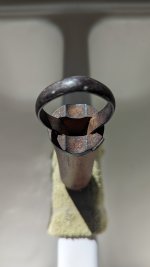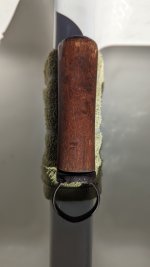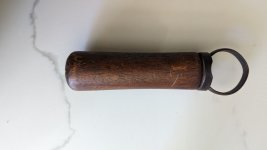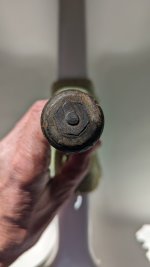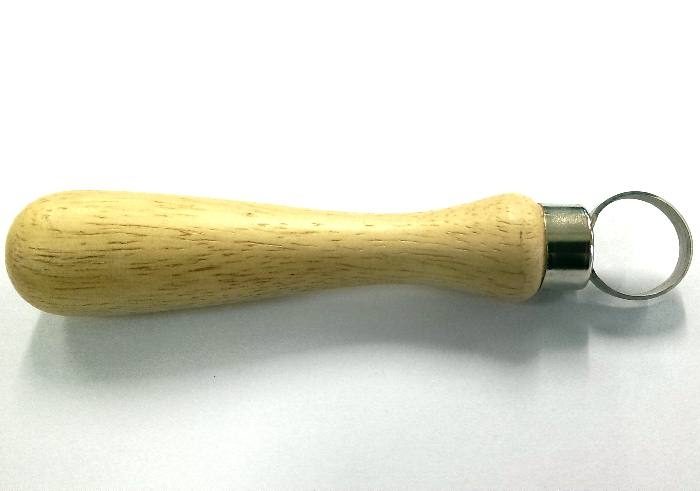Here's a good one lol. My wife's parents collected a lot of Antique kitchen stuff, not sure what the heck it is  . Any way the wood handle is 1 1/4" Dia, over all length is 6" By the way its from Pennsylvania. Thanks for any info.
. Any way the wood handle is 1 1/4" Dia, over all length is 6" By the way its from Pennsylvania. Thanks for any info.
Navigation
Install the app
How to install the app on iOS
Follow along with the video below to see how to install our site as a web app on your home screen.
Note: This feature may not be available in some browsers.
More options
You are using an out of date browser. It may not display this or other websites correctly.
You should upgrade or use an alternative browser.
You should upgrade or use an alternative browser.
✅ SOLVED Vintage Kitchen Tool ???
- Thread starter Mine Shaft
- Start date
Looks like an add-on handle for a broom or other item with a round shaft. Twist the wooden hand to tighten/loosen the metal strap.
Upvote
5
Red-Coat
Gold Member
I believe that's a "scythe nib".



From the link below:
"Up until the mid 19th century, American scythes had used the English method of affixing their nibs: an iron loop was fastened to the shaft of the snath by means of a wedge driven between the loop and the snath itself. While this allowed the nibs to be positioned at will along the snath, the wedges were prone to working their way loose at inconvenient moments, and in the industrial boom of the mid-1800’s a number of innovations were made in the means of fastening nibs. The most notable of these is the method that eventually became the standard: the so-called “Clapp’s Patent” nib. Patented in 1838 by Joseph and Erasmus S. Clapp of Montague, Massachusetts, it was the first nib known to bear the form that we see so commonly today on almost all snaths, both new and vintage. The nibs made currently by Seymour Midwest Tools are effectively of the same fundamental design."



From the link below:
"Up until the mid 19th century, American scythes had used the English method of affixing their nibs: an iron loop was fastened to the shaft of the snath by means of a wedge driven between the loop and the snath itself. While this allowed the nibs to be positioned at will along the snath, the wedges were prone to working their way loose at inconvenient moments, and in the industrial boom of the mid-1800’s a number of innovations were made in the means of fastening nibs. The most notable of these is the method that eventually became the standard: the so-called “Clapp’s Patent” nib. Patented in 1838 by Joseph and Erasmus S. Clapp of Montague, Massachusetts, it was the first nib known to bear the form that we see so commonly today on almost all snaths, both new and vintage. The nibs made currently by Seymour Midwest Tools are effectively of the same fundamental design."
Upvote
8
- Thread starter
- #10
Hi Red-Coat thank you for sharing all the info on this Vintage item. Now i know and will mark it solved. thanks you guys.I believe that's a "scythe nib".
View attachment 2068929 View attachment 2068931 View attachment 2068932
From the link below:
"Up until the mid 19th century, American scythes had used the English method of affixing their nibs: an iron loop was fastened to the shaft of the snath by means of a wedge driven between the loop and the snath itself. While this allowed the nibs to be positioned at will along the snath, the wedges were prone to working their way loose at inconvenient moments, and in the industrial boom of the mid-1800’s a number of innovations were made in the means of fastening nibs. The most notable of these is the method that eventually became the standard: the so-called “Clapp’s Patent” nib. Patented in 1838 by Joseph and Erasmus S. Clapp of Montague, Massachusetts, it was the first nib known to bear the form that we see so commonly today on almost all snaths, both new and vintage. The nibs made currently by Seymour Midwest Tools are effectively of the same fundamental design."
Upvote
1
Top Member Reactions
-
 3503
3503 -
 1970
1970 -
 1947
1947 -
 1178
1178 -
 1116
1116 -
 1001
1001 -
 878
878 -
 846
846 -
 810
810 -
 796
796 -
 748
748 -
 673
673 -
 578
578 -
 573
573 -
 498
498 -
 444
444 -
 434
434 -
E
414
-
 401
401 -
 387
387
Users who are viewing this thread
Total: 2 (members: 0, guests: 2)
Latest Discussions
-
-
-
-
-
-
New permission yields WWII ring and 9 silvers, including a spill
- Latest: E-Trac-Ohio



